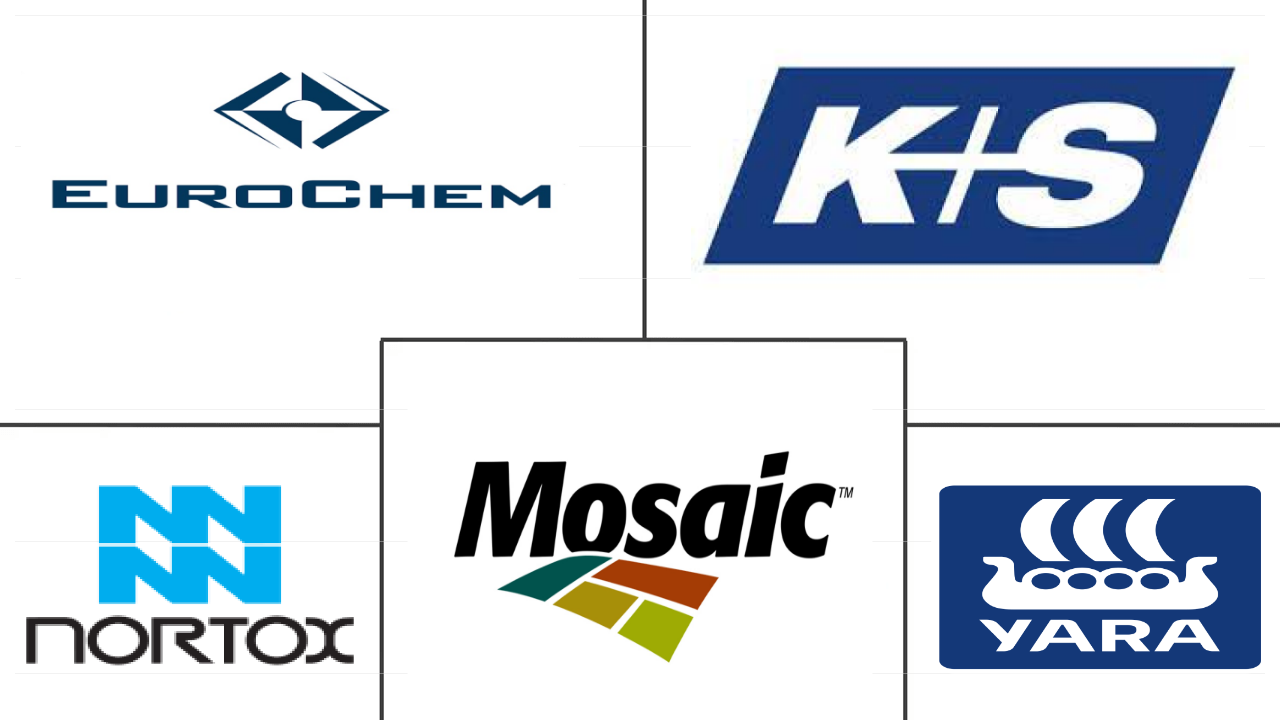Market Size of brazil micronutrient fertilizer Industry
| Icons | Lable | Value |
|---|---|---|
|
|
Study Period | 2017 - 2030 |
|
|
Market Size (2024) | USD 267.6 Million |
|
|
Market Size (2030) | USD 382.2 Million |
|
|
Largest Share by Product | Zinc |
|
|
CAGR (2024 - 2030) | 6.12 % |
|
|
Fastest Growing by Product | Molybdenum |
|
|
Market Concentration | Medium |
Major Players |
||

|
||
|
*Disclaimer: Major Players sorted in no particular order |
Brazil Micronutrient Fertilizer Market Analysis
The Brazil Micronutrient Fertilizer Market size is estimated at 267.6 million USD in 2024, and is expected to reach 382.2 million USD by 2030, growing at a CAGR of 6.12% during the forecast period (2024-2030).
267.6 Million
Market Size in 2024 (USD)
382.2 Million
Market Size in 2030 (USD)
2.73 %
CAGR (2017-2023)
6.12 %
CAGR (2024-2030)
Largest Segment by Type
28.80 %
value share, Zinc, 2023
In Brazil, Zn deficiency in soil is the most common among the micronutrients, occurring mainly in sandy soils and Latosols in the Cerrado (Brazilian Savannah) region.
Fastest Growing Type
9.12 %
Projected CAGR, Molybdenum, 2024-2030
Increasing demand for molybdenum due to acidic soil conditions and its crucial role in supporting proper plant growth makes it fastest growing micronutrient product.
Largest Segment by Crop Type
95.62 %
value share, Field Crops, 2023
The demand for micronutrient fertilizers is increasing in field crop cultivation to address soil nutrient deficiency which can significantly improve yields and quality.
Largest segment by Application Mode
95.06 %
value share, Soil, 2023
Emergence of specialty fertilizers like controlled-release and slow-release fertilizers, will increase the usage of soil application without any adverse effects on the soil.
Leading Market Player
24.07 %
market share, Yara International ASA, 2022

To serve Brazil's main agricultural markets, the Brazilian business unit of Yara operates over 20 blending units and distribution facilities with a geographical spread.
As cultivation expands and the need for micronutrients to enhance the quality and yield increases, the demand for micronutrients is expected to increase
- Zinc is the most used micronutrient in the country, accounting for a value share of 29.5% in 2022. Boron is the second most used micronutrient in Brazil after Zinc, accounting for 18.0% in terms of value in 2022.
- Molybdenum is vital for the process of symbiotic nitrogen (N) fixation by Rhizobia bacteria in legume root nodules. It is also required for the synthesis and activity of the enzyme nitrate reductase.
- A deficiency of copper significantly affects the crop yield, resulting in poor grain filling and deformed or shriveled kernels. The market value of copper fertilizers is expected to experience a CAGR of 5.4% from 2023 to 2030.
- Field crops accounted for a major share of about 95.0%, followed by horticultural crops, which accounted for about 5.0% of the total market value of boron in 2022. The rising deficiency of boron in soil due to extensive cultivation of field crops is expected to drive the growth of the market.
- The market value of micronutrient fertilizers in 2022 was USD 331.7 million, with a volume consumption of 84.0 thousand metric tons. The consumption volume of these fertilizers stayed undeterred by price fluctuation even after the pandemic when global fertilizer prices rose. Their consumption volume increased steadily, and they are expected to register a CAGR of 3.9% from 2023 to 2030.
- The market value of micronutrient fertilizers is expected to record a CAGR of 6.0% from 2023 to 2030 due to the increasing need for higher productivity and quality of produce.
Brazil Micronutrient Fertilizer Industry Segmentation Brazil Micronutrient Fertilizer Industry Segmentation
Boron, Copper, Iron, Manganese, Molybdenum, Zinc, Others are covered as segments by Product. Fertigation, Foliar, Soil are covered as segments by Application Mode. Field Crops, Horticultural Crops, Turf & Ornamental are covered as segments by Crop Type.
- Zinc is the most used micronutrient in the country, accounting for a value share of 29.5% in 2022. Boron is the second most used micronutrient in Brazil after Zinc, accounting for 18.0% in terms of value in 2022.
- Molybdenum is vital for the process of symbiotic nitrogen (N) fixation by Rhizobia bacteria in legume root nodules. It is also required for the synthesis and activity of the enzyme nitrate reductase.
- A deficiency of copper significantly affects the crop yield, resulting in poor grain filling and deformed or shriveled kernels. The market value of copper fertilizers is expected to experience a CAGR of 5.4% from 2023 to 2030.
- Field crops accounted for a major share of about 95.0%, followed by horticultural crops, which accounted for about 5.0% of the total market value of boron in 2022. The rising deficiency of boron in soil due to extensive cultivation of field crops is expected to drive the growth of the market.
- The market value of micronutrient fertilizers in 2022 was USD 331.7 million, with a volume consumption of 84.0 thousand metric tons. The consumption volume of these fertilizers stayed undeterred by price fluctuation even after the pandemic when global fertilizer prices rose. Their consumption volume increased steadily, and they are expected to register a CAGR of 3.9% from 2023 to 2030.
- The market value of micronutrient fertilizers is expected to record a CAGR of 6.0% from 2023 to 2030 due to the increasing need for higher productivity and quality of produce.
| Product | |
| Boron | |
| Copper | |
| Iron | |
| Manganese | |
| Molybdenum | |
| Zinc | |
| Others |
| Application Mode | |
| Fertigation | |
| Foliar | |
| Soil |
| Crop Type | |
| Field Crops | |
| Horticultural Crops | |
| Turf & Ornamental |
Brazil Micronutrient Fertilizer Market Size Summary
The Brazil Micronutrient Fertilizer Market is poised for significant growth, driven by the increasing demand for enhanced agricultural productivity and crop quality. The market is characterized by a diverse range of micronutrient fertilizers, with zinc and boron being the most widely used due to their critical roles in addressing soil deficiencies. The country's agricultural landscape, marked by extensive cultivation of field crops such as soybean, corn, and cotton, underscores the importance of these fertilizers in maintaining high yield levels. The expansion of arable land and the adoption of advanced agricultural practices further contribute to the market's positive trajectory. As Brazil continues to strengthen its position as a leading global exporter of key crops, the demand for micronutrient fertilizers is expected to rise, supporting the country's agricultural ambitions.
The market is moderately consolidated, with major players like EuroChem Group, K+S Aktiengesellschaft, Nortox, The Mosaic Company, and Yara International ASA dominating the landscape. These companies are actively expanding their presence in Brazil through strategic acquisitions and partnerships, enhancing their production and distribution capabilities. The ongoing efforts to address micronutrient deficiencies in soil, exacerbated by factors such as leaching and high rainfall, are crucial for sustaining crop yields. As farmers increasingly adopt micronutrient fertilizers to combat these challenges, the market is set to experience steady growth. The focus on improving soil fertility and crop resilience aligns with Brazil's broader agricultural goals, positioning the micronutrient fertilizer market as a vital component of the country's economic and agricultural development strategy.
Brazil Micronutrient Fertilizer Market Size - Table of Contents
-
1. MARKET SEGMENTATION (includes market size in Value in USD and Volume, Forecasts up to 2030 and analysis of growth prospects)
-
1.1 Product
-
1.1.1 Boron
-
1.1.2 Copper
-
1.1.3 Iron
-
1.1.4 Manganese
-
1.1.5 Molybdenum
-
1.1.6 Zinc
-
1.1.7 Others
-
-
1.2 Application Mode
-
1.2.1 Fertigation
-
1.2.2 Foliar
-
1.2.3 Soil
-
-
1.3 Crop Type
-
1.3.1 Field Crops
-
1.3.2 Horticultural Crops
-
1.3.3 Turf & Ornamental
-
-
Brazil Micronutrient Fertilizer Market Size FAQs
How big is the Brazil Micronutrient Fertilizer Market?
The Brazil Micronutrient Fertilizer Market size is expected to reach USD 267.63 million in 2024 and grow at a CAGR of 6.12% to reach USD 382.18 million by 2030.
What is the current Brazil Micronutrient Fertilizer Market size?
In 2024, the Brazil Micronutrient Fertilizer Market size is expected to reach USD 267.63 million.

